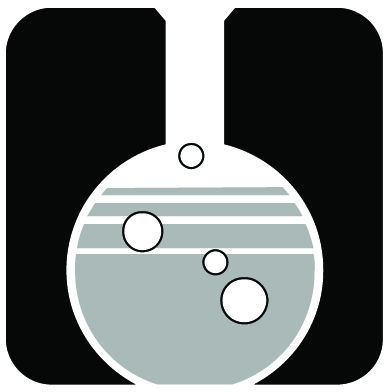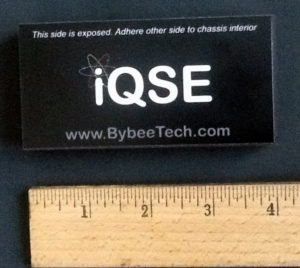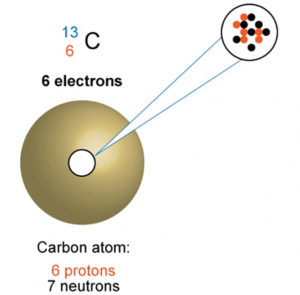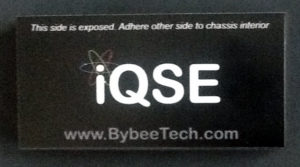Spinning Up a Room Charge
Using Bybee Room Neutralizers is easy, plus guidance is offered on the Bybee Technology website. You stick or hang 2, 3 or 4 of them on listening room walls, even behind decorations.
Depending on your room challenges, preferred placement is generally behind the speakers in or near the corners, on side or back walls, about 3-4 feet from the floor. Three are effective spread across a wall behind the loudspeakers. Additional devices (active or passive) may be placed at mirror points on the rear wall, sidewalls, on the ceiling, or behind the listening position.
Oddly, the effect is slow to develop, taking up to two or even three days to fully “charge” an area. By listening and experimenting with placement you can fine-tune for best results. But it can be a subtle process because movement of a few inches can change the sound, yet take overnight to become fully apparent. Unplugging them for a few minutes does not immediately collapse the effect, but it will dissipate quickly. The impacts of AC plug polarity or power conditioning are unknown but merit exploration.
The Black Box Problem
Bybee Technologies Room Neutralizers improve listening at a frontier where no cable technology, power conditioner or conventional room treatment can go. Amazing technologies and noteworthy innovations are being introduced to our hobby at a surprising pace. It’s unfortunate that imprecise or counterintuitive descriptions can serve to slow or block acceptance of such audio breakthroughs. Inertia, secrecy, little sympathy from the mainstream audio press, and outright hostility from dogmatic quarters slow their widespread adoption.
And sadly, in our intensely competitive global marketplace, competent detailed explanations of proprietary design concepts place them in jeopardy of imitation, reverse engineering or theft, patented or not. Commercial stealth contributes to the aura of black box mystery, hustle and voodoo. Not to mention that some of these advanced ideas remain classified secrets: “I can sell it to you, but if I explain how it works I’ll have to kill you.”
Unfortunately, this leaves inventors of effective new technologies vulnerable to critics asserting that tweaks enhance only the wallets of their purveyors, are frauds that cannot be explained with technical precision, or might actually induce distortion in otherwise well-designed components. Yet I note that such dissenters rarely actually test the validity of the claims they dispute with direct observation of their own. And, frankly, most of us don’t exactly understand how our cars, cell phones, computers or medicines work, but we appreciate their enhancements to our daily lives.
Bybee had a series of hunches followed up by research and observation, tested by trial and error (in short, the scientific method). But Jack is no bench-top inventor. For decades, his associations beyond audio have included major high tech companies from aerospace to automotive.
Bybee iQSE: “internal Quantum Signal Enhancers”
Jack’s newest invention contains a mystery material placed inside audio components, “internal Quantum Signal Enhancers” ($150). They’re small blocks (4 inches wide x 2 inches deep x ½ inch thick) containing a proprietary crystal substance that has a powerful influence in close proximity to electronics. They function similarly to his earlier, slightly larger Quantum Signal Purifiers but with a far stronger effect.
iQSE Efficacy
Bybee says his crystals activate the C-13 carbon atoms influencing protons in a predictable manner, “aligning certain molecules by reducing proton spin.” Listening demonstrates their usefulness. The benefits of iQSE in my system are improved overall detail and dynamics. Bass coherence and punch, especially the leading edge of low bass, is enhanced. Acceleration of bass attack is noticeable enough to change the apparent pacing of familiar music.
Soundstage depth, definition of instruments and the space around them are enhanced. Location cues are more vivid, apparent listening space is expanded with added depth behind the speakers. Sonic images have greater lateral extension aiding the “disappearing act.” I perceive the music floating more freely, yet at the same time being more solid and better grounded. Not surprising since these are the very qualities that Bybee products have generally contributed to my systems for years.
My David Berning OTL tube monoblock amplifiers and preamp have proven remarkably resistant to most tweaks; they responded only mildly positively to iQSE. But my loudspeakers reacted vividly.
Additional bass thrust, speed and slam resulted from attaching iQSE to my Legacy Focus SE speakers with sticky tack low in back at the terminal panels (presumably near the crossovers). Placement at top front edge of the speaker subtly encouraged a silky midrange presence and a smoothly shimmering top end; the combination taking this loudspeaker’s performance to a new level.
In fact I took the trade-off of moving two iQSE from the monoblocks in order to have four on the loudspeakers. I achieved best overall results deploying eight iQSE samples (and I bought them all). One was placed in the DAC, one in the preamp, two each on loudspeakers and two were placed at the fuse panel.
Infusing the Fusebox
One of the more striking demonstrations of iQSE was quite unexpected. Among Bybee’s early adopters, one had reported success when inserting iQSE at the inputs and outputs of a house electrical utility meter. Lacking easy access to the meter leads I stuck 2, 3 or 4 of the mildly magnetic gizmos onto the face of the breaker switch panel.
Wow, the effect was not subtle, richly multiplying the benefits mentioned above. Surprisingly, images on television from the cable box and DVD player (excluded from my AC conditioner) were more vivid. Greater color saturation and detail were conspicuous.
Keep in mind this is a recently updated home electrical system. My audio gear is treated with AC power conditioning by Synergistic Research. Household circuit-quieting products from Acoustic Revive, High Fidelity and Akiko are already deployed. Altogether it was a stunning demonstration of the efficacy and potential of Bybee’s technology. Apparently iQSE can be a powerful enhancement to household electrical systems. Naturally, your mileage may vary.
Now in his late-eighties, Jack Bybee continues to be avidly engaged in elaborate R&D. For instance he’s researching application of these technologies in electric motors and internal combustion engines. Jack says he’s demonstrated power and efficiency improvements up to 30%!
Additive Atomic Magic
These multifarious methodologies yield escalating, overlapping listening improvements. As I’ve found, tweaks need not be in the signal path nor attached to equipment for profound improvements. I love their additive, flexible nature. I’ve rarely observed a conflict usually there’s synergy.
For instance, I’m using multiple Bybee tools in coordination with other active and passive room conditioning in a listening room containing Shakti Hallographs, conventional corner quarter-tube low-frequency absorbers and an Acoustic Revive 888. The 888 is an active Schumann resonance generator, yet another valid technology, being widely developed for room/electronics conditioning.
I have yet to note a conflict between this latest generation of Bybee devices and, for instance, products from Akiko and Acoustic Revive, which also profoundly change the sound of electronics via proprietary effects. Each one a divergent technology, but each is beneficial in its own additive way.
Keep in mind that most of these products are in the range of a few hundred dollars each. Fortunately, they can be auditioned without risk thanks to the money-back policies of reputable web-based retailers. I’ve had good luck with The Cable Company and Tweek Geek, who can offer guidance, audition or 30-day returns.
From entry-level electronics to state-of-the-art gear, your equipment will richly reward proper care and feeding: clean power, high quality interconnects, vibration control, tweaks and room neutralization. Medium-quality or entry-level gear will often respond remarkably well to the mysteries I’m describing. If you love your gear yet crave an upgrade, improvement or intervention, this is an economical and entertaining path to enhancing what you already own or are likely to acquire.
These discoveries are bringing profound improvements to our hobby. Modern inventors are expanding the frontiers of our ability to intervene in our listening environment. You’re in for a pleasant surprise if you pause for investigation and let modern wizards like Bybee spin quantum pixie dust in your listening room, system and ears.
Copy editor: Dan Rubin
- ← Previous page
- (Page 2 of 2)







The Bybee iQSE is not a completely passive device. Underneath the magnet strip is a watch type battery. It will probably lose power within a year.
Jack Bybee responds that the iQSE are not POWERED by the lithium battery. But he is considering removing the battery, since it’s confusing:
“The original QSEs, were fabricated w/o batteries. I add a small lithium battery latter to further improve the effectiveness, the battery added only about 5 to 10% additional energy to the QSEs. I only did this, at no additional cost, because I wanted my customers to get more bang for the buck.
The battery insertion is not active its is not in any kind of circuit drawing any energy….in essence it is just setting there. Why it added an extra bit of effectiveness is unknown but the hypothesis it is somehow interacting with the matter that makes up the Bybee developed material. Try explaining that to the general audiophile public. The life of the battery is the same as if the battery is just setting in your drawer some place. Look up shelve life of lithium batteries on GOOGLE and you will see the shelve is over 10 years.
Everything has a resonance frequency and I theorized the resonance frequency of lithium was close to that of one of the materials utilized in the QSEs and that by adding the battery it would be possible to increase the oscillation of the QSEs making them ever more effective. Instead of a lithium battery I could have added powered lithium but would have been very dangerous.”